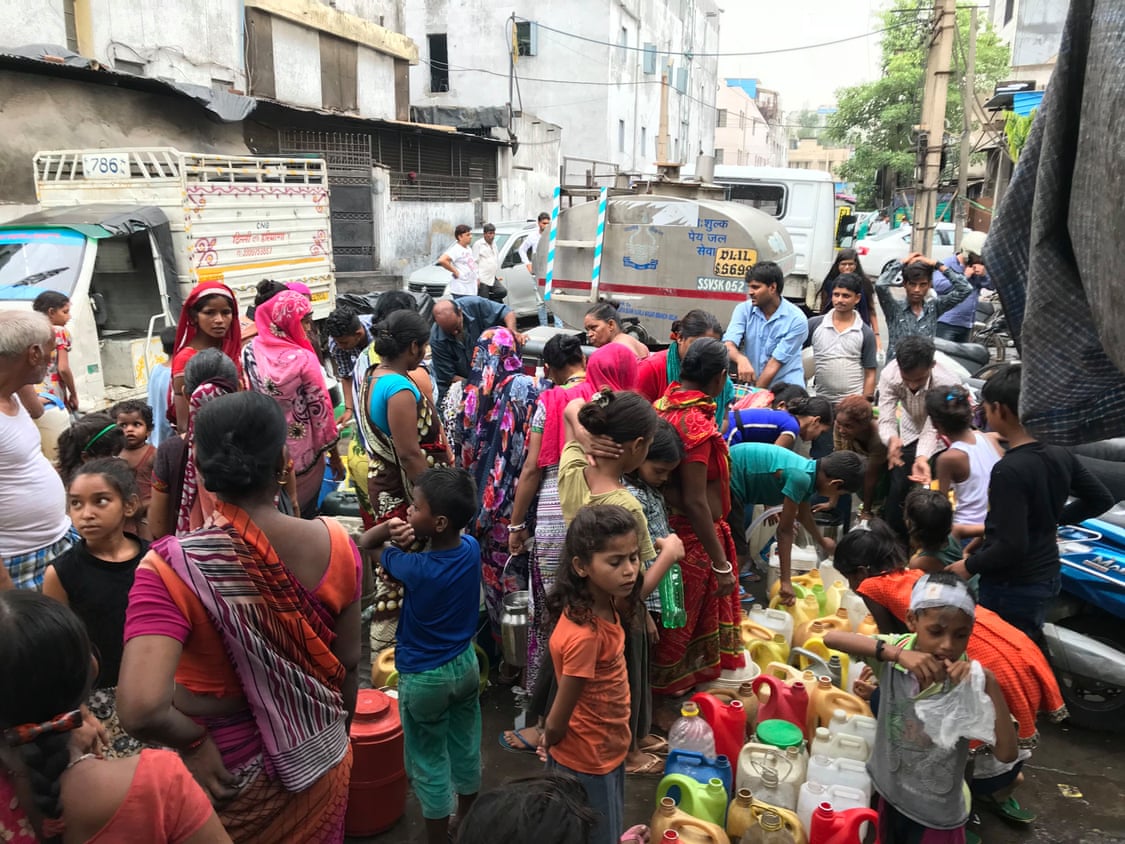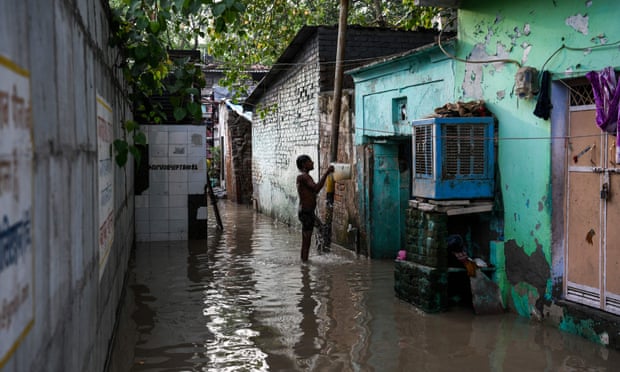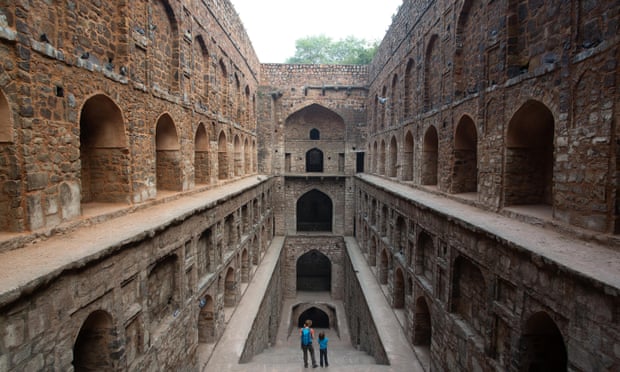- UID
- 20
- Online time
- Hours
- Posts
- Reg time
- 24-8-2017
- Last login
- 1-1-1970
|
Reports warn it could run out of groundwater by 2020. Has Delhi run out of time to reverse years of mismanagement and unchecked urbanisation?

▼ Families wait to fill water from a government tanker in Wazirpur, Delhi. Photograph: Ashish Malhotra
It’s about 4pm on a muggy monsoon day in Wazirpur, a low-income urban village in Delhi. A group of 30 women are lined up in the 34C heat (93F) behind an assortment of empty coolers, buckets, petrol containers – anything they can store water in once the government tanker arrives.
“We’ve been here since 10am,” says 55-year-old Gudi. “You never know if the tanker will come or not – we come here every day and wait.”
When it finally arrives, the waiting women rush to attach hoses. Water gushes out at full force into containers, while a few children grab plastic bottles to catch any trickles leaking from the tanker’s pipe. The deadly heatwavethat swept south Asia this summer, forcing temperatures towards 50C, was a forceful reminder that every drop counts.We never imagined someone would die over water … This has become normal
Rohit, Wazirpur resident
For many in this megacity of 29 million, this desperate jostle for water has become a part of daily life, with people sometimes missing out on work to wait for water that may not come. “It’s wrong. People who have water in their house can just fill it up in the morning and get on with their day,” says Vishnu, 60, another Wazirpur resident. “Here we wait for water and manage our routine based on that.”
Population growth, climate change, disputes between states, urbanisation and poor management of resources have made water – especially fresh, clean water – a commodity that is not readily available to all. A recent government thinktank report revealed that several major cities in India, including Delhi, could run out of groundwateras soon as 2020.

May’s heatwave has given way to monsoon flooding. In the past this water would have been stored, but resources such as rainfall are being underused, say planners. Photograph: Chandan Khanna/AFP/Getty Images
Meanwhile, temperatures continue to climb. India has seen an average increase of 0.5C over the past 50 years, leading to a rise of nearly 150% in heatwavesresponsible for at least 100 deaths. The heatwave of summer 2015 was one of the worst in south Asia’s history, killing an estimated 3,500 people in Pakistan and India. But a predicted rise of 2.2C-5.5C by the end of the century would put hundreds of millions of lives at risk, with the most extreme, quarter-century heatwaves getting even hotter.When we started getting all these supplies from distant places or tube wells ... we forgot about our local resources
Manu Bhatnagar, urban environmental planner
Currently, about 2% of India’s population is sometimes exposed to a 32C wet-bulb temperature, which factors in humidity. A 2017 study by MITfound that proportion would increase to 70% by 2100, with 2% sometimes exposed to the limit of survivability of 35C – the point at which the body cannot cool itself enough to survive for longer than a few hours.
Access to water is already a matter of life and death, with gross inequities in its distribution leading to desperate scrums. In furnace-like conditions, tensions can easily boil over. In Wazirpur in March, a 60-year-old man reportedly died of a heart attack after being beatenwith a pipe when an argument broke out over the distribution of water from a tanker.
The man’s son, Rohit, says his brother also later died from injuries sustained during the fight. “Our family has been here for 30-40 years, but we never imagined someone would die over water – now two people from our family have. This has become normal. Today it’s happened with us, tomorrow it will happen with someone else.”
Paving over history
Ironically, the fight for water now comes amid heavy rain. May’s heatwave has given way to the monsoon season, causing flooding across India. Last week flash floods in Keralakilled 37 people and displaced a further 36,000.
For much of Delhi’s history, this seasonal rainfall was harnessed for use during the summer from March to May, with water stored and distributed through check dams, stepwells (baolis) and natural drains (nullahs). It reflected a philosophy that urban environmental planner Manu Bhatnagar calls “respecting the topography”, which has since fallen by the wayside in the city.

Agrasen ki baoli, a traditional stepwell in the centre of Delhi dates back to the 14th century, but has dried up because of a lack of groundwater. Photograph: Alamy
“Everybody respected the rain … [people knew] they had to gather it,” says Bhatnagar, director of natural heritage at the Indian National Trust for Art and Cultural Heritage. “When we started getting all these supplies coming from distant places or tube wells, taking water from 300 or 400 feet [below ground], we forgot about our rainfall. We forgot about our local resources.”
The neglect of those resources is said to have much to do with Delhi’s massive urbanisation, especially in recent decades. The city’s 1976 master plan featured 201 natural drains; as of last year, only 44 could be traced. Those that remain are mostly filthy open sewers, while the rest have been paved over with roads and parks. The Delhi water board did not respond to repeated requests for an interview.Our national water policy is a fine document. But nothing got put into practice on the ground
Rashmi Verma, water policy researcher
This intense and rapid concretisation of the city also compounds the heat. “The whole city is a heat island – it’s storing the heat during the day and, during the night, it is radiating and releasing that stored heat,” says Bhatnagar. “When temperatures are higher, the soil moisture goes down and evaporation increases.”
This has not only almost entirely killed off certain water bodies – such asnullahs, which took water to the now heavily polluted YamunaRiver – but has also contributed heavily to the city’s low water table, preventing rainfall from seeping into the ground and recharging aquifers. “Delhi has lost its lakes, which are natural recharge bodies,” says Rashmi Verma, a senior researcher on water policy at the Centre for Science and Environment. “If we destroy these areas [with concrete], how can water go inside the ground?” (▪ ▪ ▪)
► Please, read the full note here: Source |
|